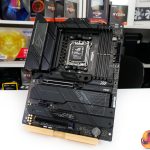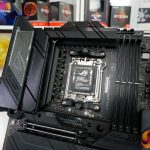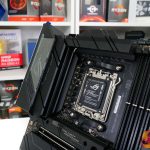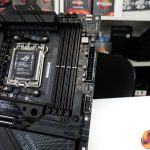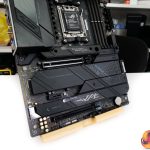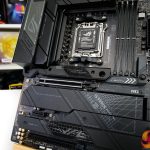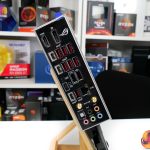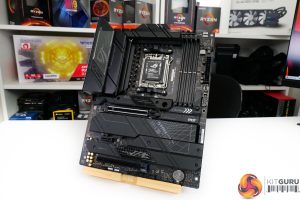Now we move onto an ROG STRIX motherboard that is priced and positioned a little higher in ASUS’ ladder than the two boards we just looked at. This is the potentially confusingly named ROG STRIX X670E-F Gaming WiFi that typically sells around the £420-or-so level.
Appearance-wise, this motherboard uses the typical ROG STRIX design. Dark blacks and greys complement a bigger, better chunk of RGB lighting on the rear IO cover.
One key area of upgrade is with the VRM heatsink. Now, we get a physically larger and better designed serving of metal on the top and left-hand sides. And both heatsinks are connected via heatpipe to share thermal load between them.
Once again we see an 8-layer PCB with dual 8-pin CPU power connectors. This time, though, the ROG STRIX X670E-F motherboard improves the VRM configuration to a 16+2 stage teamed setup using 90A components. That is a very hefty VRM indeed! And it is managed by a Digi+ VRM controller.
For the PCIe slots, the ROG STRIX board is actually a little less accommodating than its lower-priced cousins. This is because ASUS has deployed PCIe lanes elsewhere for alternative connectivity.
We still get the steel-reinforced PCIe 5.0 x16 slot with ASUS’ Q-release connector. But now, the secondary connections are a PCIe 3.0 x1 slot and a PCIe 4.0 x4 connection in the x16-sized form factor. Realistically, this setup will be fine for most users of a motherboard such as this.
M.2 connectivity gets an upgrade versus the cheaper motherboards. Now, M.2 slots 1 and 2 both support PCIe 5.0 x4 SSDs with their connection coming directly from an AM5 CPU. The remaining pair of M.2 slots support up to PCIe 4.0 x4 bandwidth and run from the X670 chipset.
All of these slots are well-cooled by metal heatsinks, too. And the top slot in particular gets a hugely oversized metal cooling block with front and rear thermal pads.
Onboard connectivity is generally similar to the Prime X670E-Pro WiFi. But there are some upgrades… and well as some downgrades, interestingly!
The ROG STRIX board offers up four SATA ports, an internal 20Gbps USB 3.2 Gen 2 Type-C header, a reinforced 5Gbps USB 3.0 header, and dual USB 2.0 headers. I’d actually like to see the triple USB 2.0 headers like on the cheaper boards. That is useful for AIO coolers and RGB hubs and the likes.
In terms of onboard RGB headers, three are ARGB and the fourth is 4-pin RGB. It is, however, highly disappointing to see no onboard power or reset buttons whatsoever on this motherboard. At this price point, I strongly feel that at least onboard power should be included. And then in terms of 4-pin fan headers, ASUS provides eight, which is great.
The densely-packed rear IO sports twelve total USB ports. These are one 20Gbps, nine 10Gbps, and two old-style USB 2.0. That’s an excellent selection, with the 20Gbps USB 3.2 Gen 2×2 running in Type-C form alongside two other 10Gbps Type-C ports.
Networking is handled by Intel components in the form of an AX210 WiFi 6E adapter and 2.5GbE NIC. Once again, we see Displayport 1.4 and HDMI 2.1 covering video output duties. While the upgraded Realtek ALC4080 codec handles audio.
Alongside the rear IO BIOS Flashback button, ASUS deploys a Clear CMOS button which is incredibly useful!
So, that’s the hands-on overview of ASUS’ ROG STRIX X670E-F Gaming WiFi motherboard. This feels like a sensible option for enthusiasts who want a premium motherboard before spending truly eye-watering amounts of money – not that this board’s typically-£400+ price point is easy to stomach, by any stretch of the imagination!
I like the strong focus on proper heatsinks, the PCIe and M.2 lane distribution looks to be excellent, and USB connectivity is ample. I would have liked to see onboard power and reset buttons, but I guess that’s a minor point for most people.
 KitGuru KitGuru.net – Tech News | Hardware News | Hardware Reviews | IOS | Mobile | Gaming | Graphics Cards
KitGuru KitGuru.net – Tech News | Hardware News | Hardware Reviews | IOS | Mobile | Gaming | Graphics Cards


